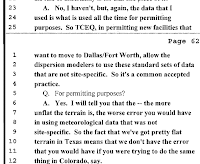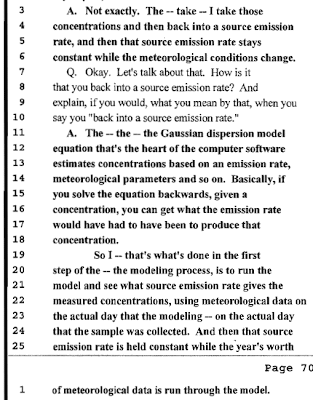As you can see, it brings forth a concern regarding carbon disulfide and uses language that completely disregards the concept of dose, which if you have been reading all 20-something of these posts, was the original issue that started me on this topic.
Okay...so again with the carbon disulfide! What does this report have to say about that chemical? Reading... reading.... oh...you have got to be kidding me. Well no wonder! Seems the same sampling method, the same analytical method, the same premise, the same model assumptions, the same poor science was involved in putting this report together.
It's Dr. Sattler's modeling work! The same methodology and the same premise was used to produce these setback findings as was performed previously for Alisa Rich. The same faulty logic that she was raked over the coals for in her December Deposition. The same methodology I have been writing about in this blog as a way to explain why it is not just wrong, but demonstrably wrong.
I have whipped that dispersion model horse enough, as well as TICs, dose, sample size, and everything else that factors into why her premise and its resulting data are wrong, so I will focus on another factor that really needs to be considered when looking at her work and the conclusion she allows to be made.
What really aggravates me about this is that she knows her work does not meet intellectually honest or scientifically sound practices. She was told this by the lawyer in the Deposition. Even if she disagreed, the prudent thing to have done was double checked his concerns. That obviously did not take place.
And now she not only puts her stamp of approval on it, she brings in another academic, Dr. David Sterling, Chair of Environmental and Occupational Health at the University of North Texas, Health Science Center. And with him on board, her work, her model's predictions, this report's conclusion, is given the seal of scientifically soundness and approval:
These professionals agreed to assess the information available and make recommendations to the FWISD which could be incorporated into future leases.This means that all three of them looked at her work and saw nothing wrong with it. How can this be?
Okay, so lets look at it strictly from a logical point of view. Let's assume that her model is correct - that every reason I have wrote about is immaterial or does not apply. So logically if the following is true:
And the model predicted:
This would mean that the emission rate from the source - an emission rate that remains constant for 8760 hours - must be producing way in excess of 241 mg/m3 if that amount was found at up to one mile from the source.
Now according to the model, under calm conditions - perfect so to speak - the concentration at 1000 meters from the stack right smack dab down the center, is 0.001 g/m3 at 1 g/s. So using that same ratio of dilution, the stack would be putting out at least 241000 mg/s or 241 grams/s of carbon disulfide.
That's a heck of a lot of carbon disulfide in and around the stack. In fact, to get that much carbon disulfide at one mile from the stack, the amount of carbon disulfide in the immediate area would be at a lethal concentration.
Here is what ATSDR has to say about carbon disulfide (241 mg/m3 = 78 ppm):
- OSHA PEL (permissible exposure limit) = 20 ppm (averaged over an8-hour work shift); 30 ppm (acceptable ceiling concentration; 100 ppm (30-minute maximum peak)
- NIOSH IDLH (immediately dangerous to life or health) = 500 ppm
- AIHA ERPG-2 (maximum airborne concentration below which it is believed that nearly all persons could be exposed for up to 1 hour without experiencing or developing irreversible or other serious health effects or symptoms that could impair their abilities to take protective action) = 50 ppm
- Inhalation is the major route of exposure to carbon disulfide. The vapors are readily absorbed by the lungs. The odor threshold is approximately 200 to 1,000 times lower than the OSHA PEL-TWA (20 ppm). Odors of pure or commercial grades of carbon disulfide usually provide adequate warning of hazardous concentrations
So if the model she predicts 241 mg/m3 is true, the output - "E" - must be producing carbon disulfide in abundance in order to push that much carbon disulfide down the plume to a distance of one mile.
And if that were true, people living in and around these sites at less than1000 meters would be constantly smelling an odor, and - most significantly - these oil & gas production sites would have a lot of very sick or dead workers.
And that is just not happening. Do people complain about odors? Yes, but at Dr. Sattler's calculated emission rate, the smell would be constant and never ending since the odor threshold is between 0.1 and 0.2 ppm. And if the level at one mile is 3 times the PEL, the workers at the source would be experiencing consistent health related problems.
This is not happening because there IS NO carbon disulfide being produced at these sites above an amount that will exceed an ESL, cause long or short term harm, or produce an odor. Not at one mile nor next to the site. None...at any distance around the facility.
So once again, to show why:
- Dr. Sattler's premise that you can "back in" a concentration to obtain the emission rate "E" is wrong.
- Dr. Sattler's positive identification of carbon disulfide - using EPA Method TO14 - is wrong.
- Dr. Sattler's quantification of carbon disulfide - identified by the lab as a TIC - is wrong.
And because these three things are wrong, her model's predictions are wrong - not off by a little - but wrong.
And because her model's predictions are wrong, the conclusion of the report - based on carbon disulfide concentrations - is wrong.
Next post: Air Quality in the Barnett Shale - Part 24: How confident in that 33.6 ug/m3 are you?
.

































